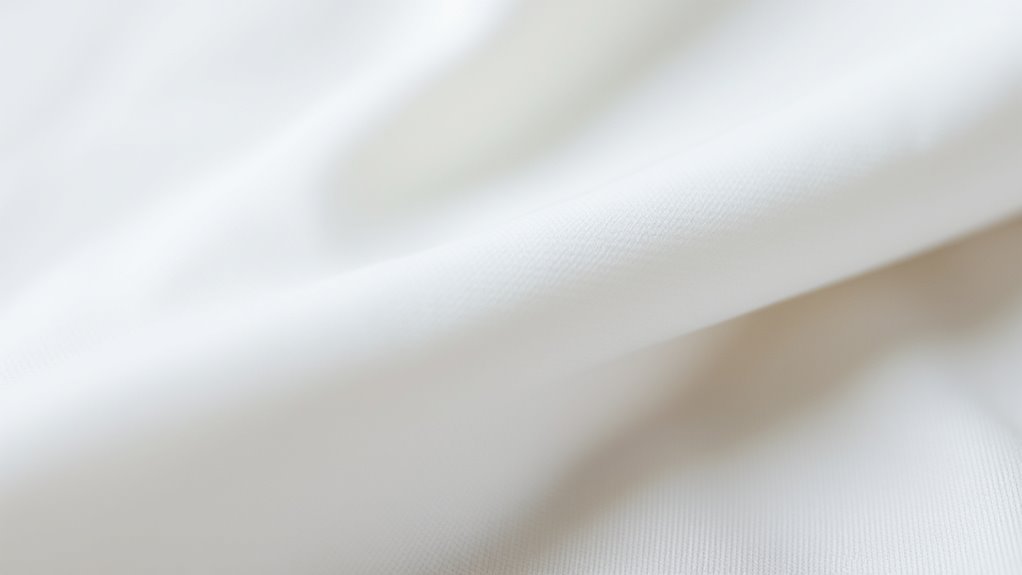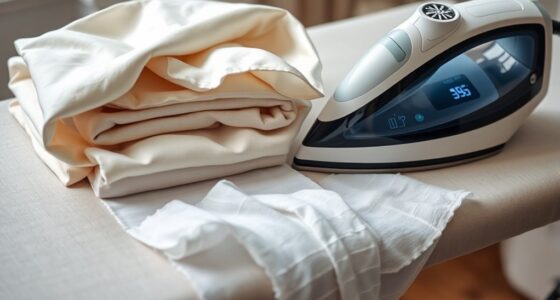To prevent pilling and keep fabrics smooth, use gentle washing cycles and wash similar fabrics together to reduce friction. Turn garments inside out and avoid overloading the washer. Incorporate fabric softeners to minimize fiber abrasion and friction during washing. Opt for air drying or low-heat drying to maintain fabric integrity. Handle clothes carefully and use a lint remover or shaver as needed. Continuing with these tips can help your clothes stay newer longer.
Key Takeaways
- Wash delicate fabrics inside out on gentle cycles to reduce fiber abrasion.
- Use fabric softeners regularly to coat fibers and minimize friction during washing.
- Air dry or select low-heat settings to prevent heat-induced fiber weakening.
- Turn garments inside out and wash similar fabrics together to prevent unnecessary rubbing.
- Regularly use a fabric shaver or pill remover to maintain a smooth, pilling-free surface.

Pilling can quickly ruin the appearance of your favorite fabrics, but you can prevent it with simple care techniques. One effective method is paying attention to how you wash your clothes. Selecting the right washing machine settings is essential; opt for gentle cycles when washing delicate or knit fabrics that are prone to pilling. Using a gentle cycle reduces agitation, which minimizes fiber abrasion and keeps your clothes looking newer longer. Also, avoid overloading the washing machine, as overcrowding causes more friction between garments, increasing the likelihood of pills forming.
Choose gentle wash cycles and avoid overloading to prevent fabric pilling.
In addition, incorporating fabric softeners into your laundry routine can help prevent pilling. Fabric softeners coat fibers with a lubricating layer, reducing friction during washing and wearing. This lubrication lessens fiber breakage and fuzz formation, which are the primary causes of pilling. Be sure to follow the instructions on the fabric softener bottle for proper use, and consider using it with every wash for fabrics that tend to pill. However, keep in mind that some fabrics, like microfiber or certain athletic wear, may not respond well to softeners, so always check the care label first.
Proper drying techniques also play a vital role in pilling prevention. Air drying or using a low-heat setting on your dryer helps maintain fabric integrity. High heat can weaken fibers, making them more prone to breakage and fuzz buildup. When using a dryer, remove garments promptly to prevent excessive friction from tumbling, which can cause pills to form.
Another tip is to turn garments inside out before washing and drying. This reduces direct friction on the surface, protecting the outer fibers from rubbing against other items and the machine drum. Additionally, washing similar fabrics together prevents rougher textiles from causing unnecessary abrasion on more delicate items. For example, wash towels separately from soft knits or sweaters.
Finally, consider investing in a fabric shaver or pill remover for occasional touch-ups. While prevention is best, removing pills from any fabric that has already developed them can restore their smooth appearance. Regular maintenance combined with proper washing and drying techniques will extend the lifespan of your clothes, keeping them looking fresh and new longer. By paying attention to washing machine settings, using fabric softeners appropriately, and handling your garments carefully, you can greatly reduce pilling and enjoy your favorite fabrics for years to come. Additionally, choosing fabrics with fiber resilience can help fabrics stay smooth longer and resist pilling over time.
Frequently Asked Questions
Can Fabric Softeners Prevent Pilling?
Fabric softeners can help reduce pilling by making fibers smoother, but they aren’t a guaranteed solution. Their benefits include softer fabrics and less static, but drawbacks involve potential buildup that can weaken fibers over time. To prevent pilling, use fabric softeners sparingly and opt for gentle detergents. Combining these with proper laundry habits will keep your fabrics looking fresh and smooth longer.
Does Washing Inside Out Reduce Pilling?
Washing your garments inside out can help reduce pilling by protecting the fabric weave from friction during laundry. When you do this, you keep the outer surface less exposed to rougher fabrics or agitation, which can cause pilling. Also, make certain the garment fit isn’t too tight, as tight fits increase friction and wear. Proper washing habits preserve the fabric’s integrity, keeping your clothes looking smooth and fresh longer.
Are Natural Fibers Less Prone to Pilling?
You might find that natural fibers like wool or cotton are less prone to pilling than synthetic ones. For example, a case study shows that high-quality cotton shirts maintain their smoothness longer due to superior fiber durability. While natural fiber types generally resist pilling better, their durability varies. Choosing well-made natural fabrics can help you enjoy garments that stay smooth and less prone to fuzz balls over time.
How Does Drying Method Affect Fabric Pilling?
Drying method substantially impacts fabric pilling. Using a high heat drying technique can weaken fibers, making them more prone to pilling, while air drying helps preserve fabric integrity. Avoid over-drying and skip fabric softener, which can coat fibers and increase friction. Instead, opt for gentle drying settings and lay clothes flat or hang them to dry. These steps keep fabrics smooth and reduce pilling over time.
Can Pilling Be Reversed Once It Occurs?
Pilling can’t be completely reversed, but you can improve your fabric’s appearance through fabric repair and pilling removal. Use a fabric shaver or a pumice stone to carefully remove pills without damaging the fibers. Regular maintenance helps keep your fabrics smooth and extend their lifespan. Keep in mind, though, that some pills may be stubborn, so gentle handling is key for the best results.
Conclusion
By following these tips, you’ll keep your fabrics smooth and looking new. Think of pilling like a pesky weed in a garden—if you catch it early and tend to it regularly, it won’t take over. I once ignored a sweater’s early fuzz, and it quickly became a tangle; now I check my clothes often. Stay proactive, and you’ll enjoy longer-lasting, better-looking fabrics that stay fresh and smooth, just like a well-tended garden.









